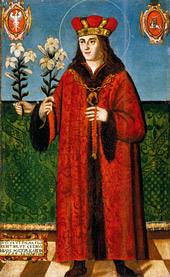Saint Casimir
St Casimir is the patron saint of Lithuania and one of Poland‘s patron saints. He was named patron of Lithuanian youth in 1948, and in 1960 became patron of the members of the Order of Malta (Joanites). Born in Krakow on October 3, 1458 as the second son in the royal family, Casimir did not enjoy a long life. He died at age 25, on March 4, 1484, at Gardinas Palace in Lithuania. One of the most striking events in Prince Casimir’s life was a 1471 march on Hungary, where his mother sought to enthrone him as the rightful Hungarian ruler. The campaign ended in failure, but gave Casimir some valuable political experience and helped him to mature spiritually. Casimir’s father increasingly involved him in affairs of the realm, recognizing in him the traits of character that were apt for a ruler: political discernment, intelligence, charisma and when needed the ability to be strict and firm.
At the same time, Casimir stood out from many of the rulers of his epoch. Rather than take advantage of his high status and political power, he avoided any extravagance. In duties of state, he gave priority to being just with everyone. Casimir firmly opposed immoral customs of the environment in which he lived. Rejecting the cult of pleasure, he chose to live according to his conscience and tried to follow the example of Jesus. He was considerate with all, attentive to the needs of the poor and a frequent visitor of the sick. His relatives, who found such behaviour incomprehensible, reproached him and urged him to change. What particularly amazed the royal court was this young man’s determination to remain chaste. Conventions of the time held promiscuity to be a boon for one’s health. Casimir expressed his own view of the matter in the still famous motto: “Better die than sin!” The holy prince spent the last two years of his life in Lithuania, mostly in Vilnius, where he had a special fondness for the Cathedral. Praying there, he would sometimes lose track of time and forget the meals where he as heir to the throne was obliged to sit at table with Lithuanian officials and foreign guests. The prince, it is said, frequently prayed during the night and early morning by the doors of the Cathedral. He was especially devoted to the Blessed Virgin Mary.
When Casimir died in 1484, he was buried in the Royal Chapel of Vilnius Cathedral, where his mortal remains stayed for more than 100 years. Immediately after his death, word began to spread about miracles that had occurred through his intercession. The holy prince’s aid was felt by individuals and by the country as a whole: in a battle with the Russians, St Casimir appeared to the Lithuanian and Polish troops in the form of a white horseman like that on the Lithuanian coat of arms. Respect for Casimir spread, and votive offerings began to appear by his tomb as tokens of appreciation. His canonization process was begun at the start of the 16th century, and in 1604, after Pope Clement VIII brought the process to its conclusion, Casimir was declared a saint in a solemn ceremony at Vilnius Cathedral. A huge and joyous procession bearing St Casimir’s flag filled the streets of Vilnius on that occasion. In 1636, the holy prince’s coffin was transferred to the newly built Chapel of St Casimir. That chapel and the entire Vilnius Cathedral were devastated during warfare between 1655 and 1661 when the Russian military occupied Vilnius. The saint’s remains, removed and hidden during the war, were returned to the cathedral in 1667. The Chapel of St Casimir underwent renovation works in 1692, and since then has remained largely unchanged. The body of the saint was again temporarily removed at the start of the 18th century, during the Russian-Swedish war. The Soviet occupation brought the longest “exile” for St Casimir’s relics, nearly four decades, while the cathedral was closed. His coffin was carried back there in triumph on March 4, 1989, from safekeeping at the Church of Sts Peter and Paul.








